In this piece, Elena Lazos Chavero draws on years of fieldwork in the Sierra de Santa Marta of Veracruz to illuminate how livestock-raising has spread into the region’s indigenous territories, and the role livestock have played in Mexico’s recent history.
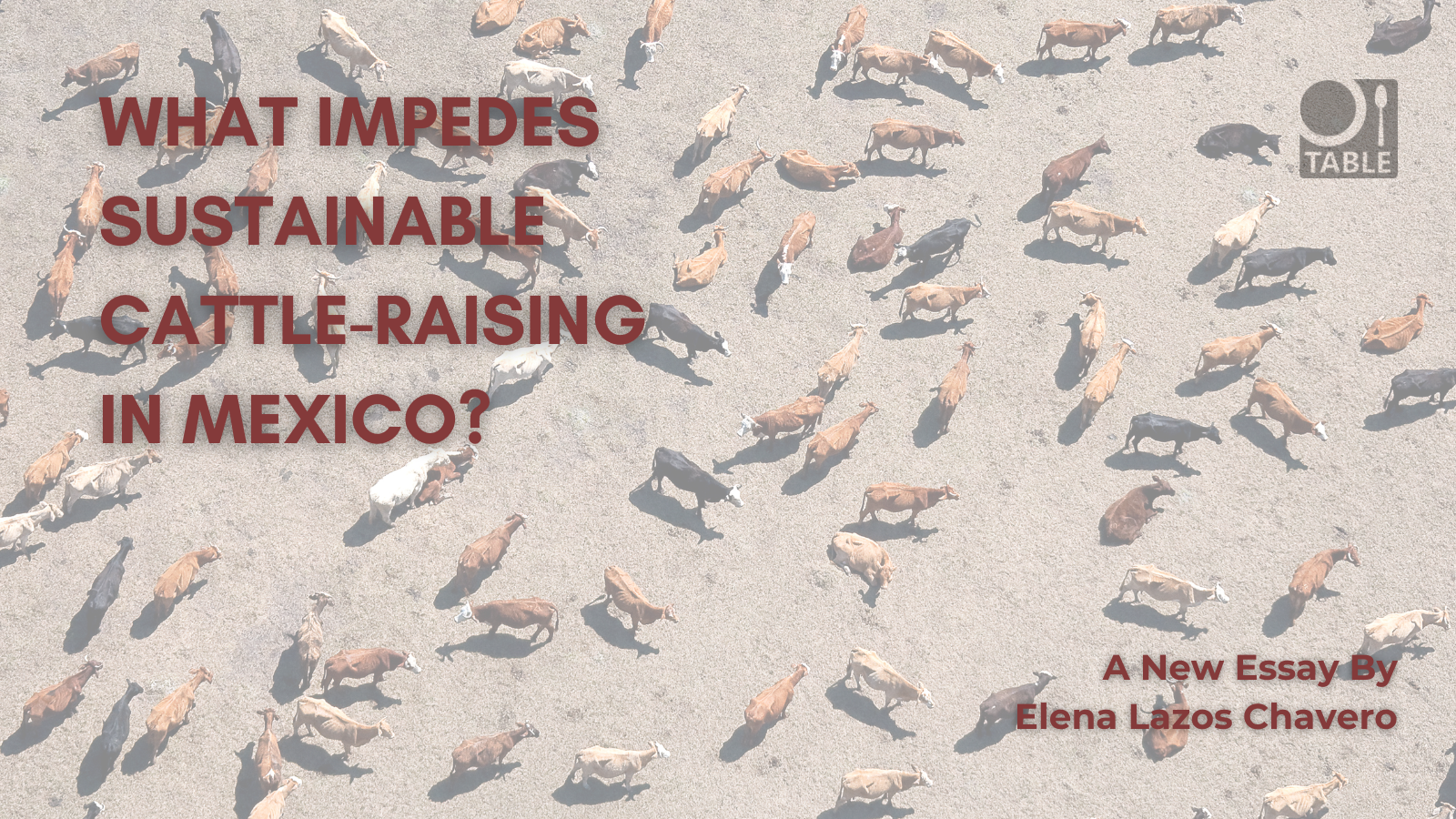
Introduction: how cattle has transformed the tropics
In order to identify the socio-environmental, economic, cultural, and political challenges to transforming conventional extensive livestock-raising into sustainable livestock-raising in tropical regions of Latin America, we must understand the socio-environmental, economic, and political changes that have taken place since the 1950s in those regions. These changes have been in accordance with a livestock-raising model imposed through national and international policies, which have led to the spread of livestock-raising on peasant and indigenous land. Based on several years of fieldwork in the Sierra de Santa Marta of southern Veracruz, I present a historical perspective of the causes and consequences of large-scale private landholders spreading this livestock raising model onto peasant land, by addressing the following questions:
- How did livestock raising begin in tropical areas of Latin America, and in particular in the Sierra de Santa Marta of Veracruz, and how did it spread into peasant and indigenous territories?
- What conditions have enabled the extensive livestock raising model to transform peasants’ communitarian structure and to devastate forests?
- How have large-scale livestock raisers come to control land and gain political power?
Following this, I provide a general overview of development of cattle raising in the Sierra de Santa Marta of the Los Tuxtlas Region of southern Veracruz (Figure 1), as this case study exemplifies the gradual process of expansion over one of the evergreen rainforests in Latin America with the highest levels of biodiversity and endemism (Dirzo & García, 1992). Finally, I analyse the socio-political, economic, ecological, and cultural challenges that impede the transition from conventional to sustainable livestock raising by small and medium-scale livestock raisers of the region.
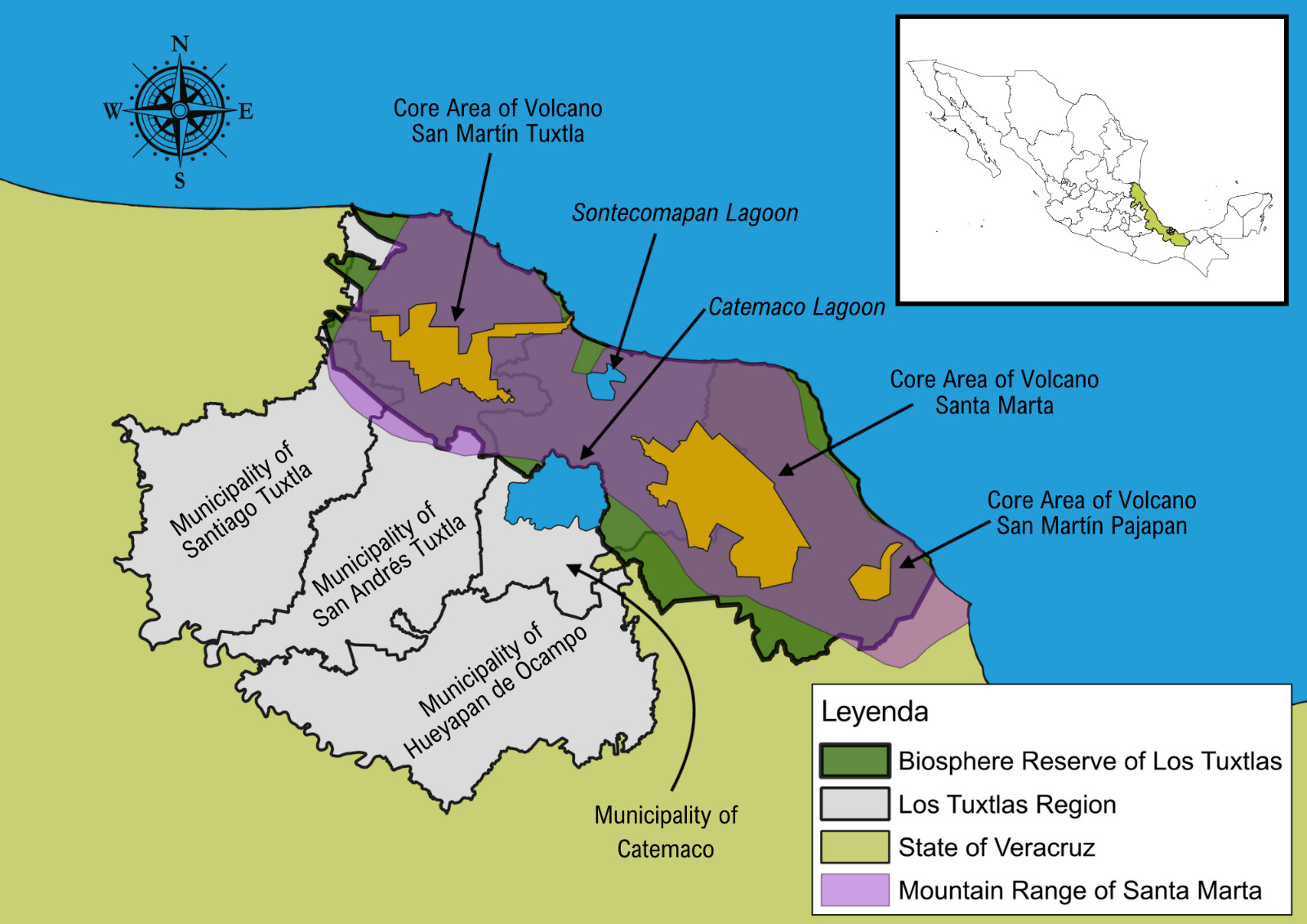
Colour-coded map of the location of the Sierra de Santa Marta, the Los Tuxtlas region, and the Los Tuxtlas Biosphere Reserve in southern Veracruz, Mexico. Designed by Jazmín Solís Carpio, based on INEGI maps.
Brief history of livestock raising in Mexico
From the start of the Spanish colony in the 16th century in what is now Mexico, colonizers invaded diverse types of croplands of indigenous populations, as well as forests, in order to establish extensive livestock raising in haciendas1, occupying large land areas. While they often fenced in their livestock, on many occasions they let them roam free, thereby invading and destroying indigenous peoples’ milpas (polyculture of maize, beans, squash, root crops, chilli, and other crops) unless those peoples fenced in their land (Reina,1998; von Wobeser, 2019). This model continued even after Independence, until 1915 when the Mexican Revolution began as a result of peasants’ struggles for land. Following the revolution, the State slowly began a project of agrarian reform to distribute hacienda land to landless indigenous people and other peasants.
During the 20th century, three types of property existed in Mexico:
- Small private property, which originated from large haciendas selling or subdividing their property into landholdings of 100-2000 hectares, often later further sub-divided among family members. Other small private properties - known as “colonies” – which resulted from the national government granting land as compensation for military or other types of service.
- “Communal land” formalised by land titles which were given by the Spanish Crown during colonial times to those indigenous communities whose traditional landholdings were recognised by the Crown. However, most communities with de facto communal landholdings were not recognized upon colonization and lost their land during colonial and post-colonial times.
- Ejidos which resulted from organized groups of peasants struggling to obtain communal landholdings, in accordance with agrarian reform to distribute hacienda land to landless peasants passed in 1917 following the Mexican Revolution. Most ejidos were established from 1936 to 1980. Each ejido – in their members’ assembly - decided whether to work the land collectively or individually, the majority deciding to distribute their land and work individually. Plot size varies greatly depending on the size of each ejido (a total of 80-600,000 ha); however, families generally were granted 0.5 to 30 ha. (Pérez y McKinlay 2015).
Following the 1910-17 Mexican Revolution, Mexico’s Agrarian Law (Article 120 of the Mexican Constitution) was passed, establishing small properties used for agricultural crops as having a maximum surface area of 100 hectares; larger landholdings could be expropriated and redistributed to peasants in the form of ejidos. However, those raising livestock were allowed to own the amount of land necessary to maintain a herd of 500 cattle according to local environmental conditions, calculated corresponding in principle to the land’s carrying capacity, but these considerations allowed to concentrate more land. As the indicators were not clear, the big landowners could declare that they needed more land.
During the early and mid-20th Century, the livestock-raising elite’s economic and political power was consolidated through legal changes that benefitted them, including Mexico’s Law of Livestock Raisers’ Associations, passed in 1936 during the administration of President Lazaro Cárdenas.2 Not surprisingly, wealthy livestock raisers have occupied high positions in public administration as governors, congress members, and municipal presidents (Rutsch, 1980; Velázquez, 1992). Amendments to constitutional Article 27, passed during the administration of Miguel Alemán (1946-1952), provided obstacles to repartitioning land used for livestock raising to peasants and granted long-term protection to large-scale livestock hacienda owners. Feder (1982: 247) demonstrated that from the mid-1960s to late 1970s, livestock raising in Latin America - particularly in Mexico - was highly moulded by World Bank and International Development Bank loan policies which had the objective of increasing production of livestock products, providing large-scale cattle raisers with greater control over production, and benefiting the North American meat industry (e.g. By 1959, McDonald’s – with annual sales of 50 million dollars - was seeking foreign meat sources). In the 1970s, livestock raising was carried out on 65% of Mexico’s surface area (Chauvet, 1999), with the number of livestock growing at a rate faster than that of the human population, and livestock raising contributing 5.8% of the Gross Domestic Product (GDP).
Studies carried out since the 1980s have helped to comprehend four aspects of the widespread implementation of livestock raising:
- Imposition of an external economic model on Latin America since the 1950s by transnational companies, international financial capital, and a land-grabbing conservative bourgeoisie working to advance their economic interests (Reign, 1982; Feder, 1982), with the intention of taking hold of greater land areas;
- Growth in power of a political elite as a result of land-grabbing to raise livestock;
- The role of national agricultural policies in the spread of livestock raising along with reduction in cropland and forests as the government promoted transformation of “non-productive” forests into agricultural land;
- Expansion of agricultural frontiers in tropical areas of southern Mexico (to a large extent through the program “March toward the Sea”) upon distributing land to landless peasants from central Mexico (Revel-Mouroz, 1980; Fernández et al., 1993; Tudela, 1989).
As this extensive livestock raising model involved large landholdings, it entered into contradiction with post-revolutionary agrarian reform aimed at increasing the land-holding peasant population and promoting dietary self-sufficiency through staple crops. Furthermore, it counteracted the few existing forest conservation programs. As a result, some academics denounced livestock raising for extensively using land while intensively using nutrients, water, and grains. In the words of Toledo (1990), “…cattle raising, as it is extensive, devours maize fields and confronts cattle with men” (Toledo, 1990; Velasco, 1993: 96).
Livestock raising spread in different manners, according to type of land tenancy. Owners of large landholdings - many of which had formerly been livestock haciendas - managed livestock extensively over large areas. They had no need to incorporate technological innovations to intensify livestock production; rather, cattle raising provided an excuse for land grabbing. The regional climate determined the number of cattle raised per hectare. As the agrarian reform authorized landowners to have 500 head of cattle, in arid regions haciendas covered up to 2500 hectares, while in tropical areas they covered 400-800 hectares.
During the late 1970s, communal landholders and ejido members gradually began to raise livestock, initially renting their land to large-scale cattle raisers, and later raising their own cattle. Initially they raised 2-10 cattle, setting them free during the day in forests surrounding the communities, and in the afternoon taking them back to the community. However, they devoted most of their time to cultivating milpa.
Of Mexico's 196 million hectares, 100 million hectares currently consist of collective landholdings, distributed among 29,495 ejidos and 2348 communities. Land tenure is currently distributed as follows:
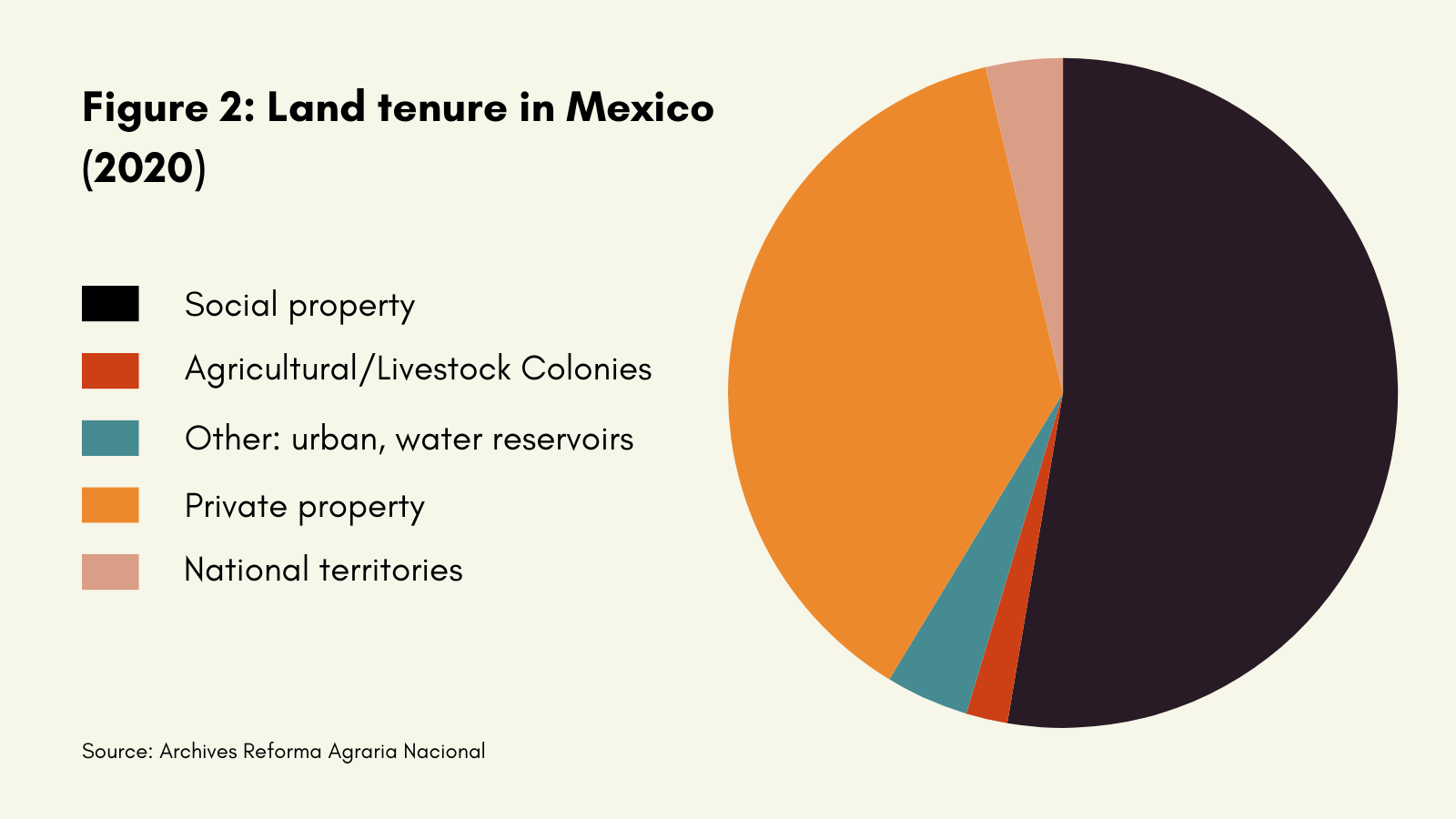
Figure 2. Land tenure in Mexico (2020). Source: Archives Reforma Agraria Nacional.
The number of head of cattle in Mexico has grown at an accelerated rate since 1950 (Figure 2), with the highest rates of growth having occurred in the 1970s, a slight decline in the late 1980s, and an upturn since 2000. Despite several economic crises, livestock raising has extended over the majority of Mexico’s tropical peasant and indigenous land.
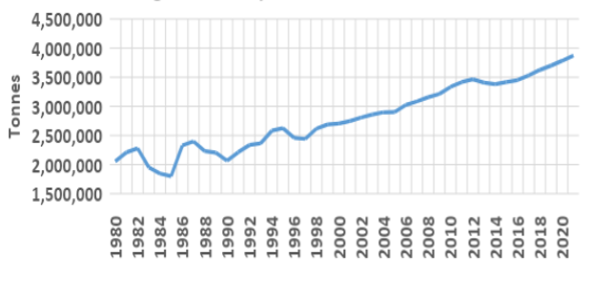
Figure 3. Cattle Production in Mexico (1980-2020). Source: Servicio de Información Agroalimentaria y Pesquera (SIAP). Anuario Estadístico de la Producción Ganadera. Consulted March 22, 2023.
Deforestation as a result of the expansion of livestock raising
Several studies have shown that aside from land-grabbing, the second-most significant impact of implementing livestock raising in tropical land is accelerated deforestation. In the 1990s, Latin America (15.8% of the global surface area) contained 23% of the world’s temperate forests and 57% of its tropical forests. During that decade, the world’s six most biodiverse nations - three of which are in Latin America - contained 80% of global biodiversity. Nevertheless, since the late 1970s, Latin America has also had higher rates of deforestation than any other continent.
In southern Mexico, forested area decreased by 50% from 1950 to 1980, particularly from 1970-80, while grasslands increased by 157% from 1970 to 1979 (Rutsch, 1980: 167-168) (Figure 3). In the 1970s, the state of Veracruz had Mexico’s third highest level of biodiversity, and 65% of its surface area was covered by high evergreen forest (accounting for 23% of the nation’s forests). Over the past 50 years, 91% of its forest cover has been eliminated (Ordóñez & García, 1992).
Much environmental destruction in tropical areas of Latin America in the past five decades has resulted from actions by transnational lumber and mining companies. Nonetheless, agricultural extractivism and national agricultural development plans (Collins, 1986; Hecht & Cockburn, 1990; Hurst, 1990; Adams, 1992) involving monocultures and extensive livestock raising have extended into indigenous and other peasant communal landholdings, causing further environmental degradation.
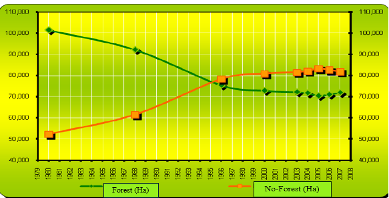
Figure 4. Transformation of forested habitat to non-forested land in the Los Tuxtlas Biosphere Reserve, Veracruz (1980-2008). Source: Velasco Tapia, 2009.
Replacement of agroforestry systems and milpas by extensive livestock raising in southern Veracruz
A long-standing debate exists regarding the causes of deforestation in tropical areas of southern Latin America, with some holding that external extractivist industries have been the major cause (Collins, 1986; Hecht & Cockburn, 1990; Hurst, 1990; Adams, 1992), while others emphasize the role of expansion of cattle raising (Barrera and Rodríguez, 1982; Toledo, 1990). Livestock raising boomed in central Veracruz from 1950 to 1970, while in the rest of the state the highest rate of increase occurred from 1970 to 1980 as a result of international financing (Barrera et al, 1993; Lazos, 1996). Southern Veracruz – where mining and other external extractivist industries did not take place until 1950 - is a clear example of deforestation due to cattle raising (Figure 3). From 1950 to 1986, the number of cattle increased more than tenfold from 206,000 to 2,371,000, while the area of grasslands increased from 430,000 hectares to 1,124,000 hectares (Figure 4).
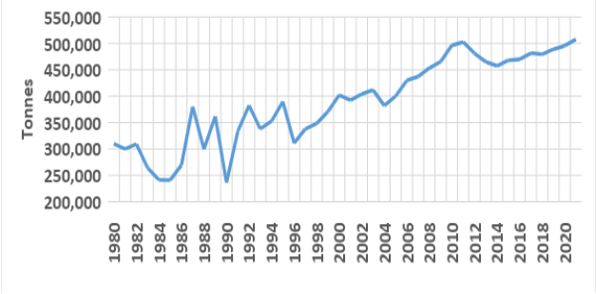
Figure 5. Cattle production in Veracruz (1980-2020). Source: Servicio de Información Agroalimentaria y Pesquera (SIAP). Anuario Estadístico de la Producción Ganadera. Consulted March 22, 2023.
In the 1970s, livestock raising in Veracruz began to extend to ejido and communal landholdings smaller than 5 hectares. From 1960 to 1990, the percentage of head of cattle in properties smaller than 5 hectares increased from 25% to 43% (Lazos, 1996). In the Nahua communities of the Sierra de Santa Marta (particularly in the largest communities – (Pajapan, Mecayapan, Tatahuicapan), ejido members gradually became small-scale livestock raisers, while mestizos3 from central Veracruz establishing new communities in the region in the late 1960s and 70s – many of whom brought cattle with them - became medium- and large-scale cattle raisers. The first Nahua ejido members to raise livestock either rented part of their land to mestizo livestock raisers or established “cattle-sharing contracts”4.
Large-scale mestizo livestock raisers rented grassland for their livestock from Indigenous peasants or other mestizos of nearby villages. In exchange for one year’s use of grassland, they set up the region’s first barbed wire fences to contain their cattle. Local peasants cleared rainforest to rent their land to large-scale cattle raisers. However, renting to mestizo livestock raisers led to violent competition among indigenous people over communal land. As a result, land distribution came to be so inequitable that those with less land protested, demanding more equitable repartition of land within ejidos. In the late 1980s, in an effort to halt the violence, communally elected authorities redistributed land among the population. Nevertheless, communal authorities gave more land to more powerful community members (e.g. large-scale livestock raisers, communal authorities, municipal politicians), and some ejido members continued to hold more land than others (Velázquez, 2000; Lazos, 1996).
Meanwhile, large-scale mestizo livestock raisers established cattle-sharing contracts in order to obtain more land on which to raise cattle. This system accentuated inequality between the mestizo owners of the cows and the owners of the land. Once their land was fenced in, the peasants stopped renting it and began to purchase additional cattle with profits from the sale of crops or pigs. One Nahua cattle raiser from Tatahuicapan stated, “The savings to purchase cattle came from selling piglets because beans and maize were sold very cheap. My dad bought 15 piglets and we raised them and then took them to sell in the city, and with that money my dad little by little purchased calves”.
As livestock raising is a predominantly male activity, availability of male labour often determined how much area was deforested, fenced in, and appropriated for livestock raising. Many families relate differences in extension of livestock raising to availability of labour. As one Nahua resident of Tatahuicapan stated, “They could fell a lot of tropical forest because there were several sons who went every day to cut down trees. We only had one son, so our plot remained small”.
Meanwhile, crop failure due to unstable climatic conditions led small and medium-scale peasant and indigenous families to accelerate land-use transformation to cattle raising. Mestizos as well as Nahuas dreamed of a way of life that would alleviate their poverty, and livestock raising promised a better way of life than the milpa. One mestizo resident of the community Benigno Mendoza stated, “There where I’m from, the livestock owners are the rich ones. The poor peasants don’t escape poverty”. A Nahua resident of Tatahuicapan stated, “….in the milpa, one works from six to six, and you have to do the clearing. Then with the drought it doesn’t grow well, and then even if it does grow - the maize, the beans… they’re [sold] very cheap. It doesn’t pay off. I saw that that man had nice animals and I see that he sells his animals, and he receives good money… We saw the rich livestock owners… Really, can’t we have that too?”
Thus, livestock raising began to replace traditional agroforestry, in which forests were rotated with milpas. Initially, naturally growing grasses were used, but later grasslands were planted, and pastures fenced in, resulting in privatization of communal land. Grass seed was provided by the cattle raisers. This model of livestock raising permanently transformed rainforests into grassland by interrupting the cyclical process of shifting cultivation, which involved cultivation of milpa for two or three years followed by 15 to 20 years of fallow to allow the rainforest to regenerate. With livestock raising, although complex ecological dynamics exist among grasses, milpas, and fallows (Lazos, 2001; Flores, 2014) and pastures are rotated with crops, mature rainforests are unable to re-establish themselves, and to this day cropland is increasingly being replaced by grassland.
In summary, the following conditions led to conversion of diverse Nahua milpas and rainforests into pastures: stagnation of low maize prices from 1960 to 1985 along with easy access to loans for livestock raising; renting of land by mestizo livestock raisers of the region; lack of crop loans or other sources of income; absence of a regional agricultural market; uncertainty of harvests; lack of capitalization; and lack of labour due to high rates of seasonal migration to regional industrial cities. The resulting rupture of the cyclical agroforestry model (forests – maize polyculture cultivation - forest regrowth) led peasants to adopt a model that promised them a better future.
Challenges to transitioning to sustainable livestock raising
Typology of livestock raisers in Veracruz
Currently in Mexico as a whole, 58.3% of livestock raising is free range, while in the state of Veracruz 73.6% is free range, and in southern Veracruz 88%. Types of livestock raising in Veracruz are: a) free-range, b) free-range grazing combined with indoor-raising; c) semi-enclosed, and d) indoor-raising (Figure 5). The free-range systems are almost exclusively carried out in extensive pastureland, without any infrastructure or investment in intensive management practices to reduce pasture area. Although silvopastoral systems have been proposed since the 1990s in tropical Latin-America (Pezo & Ibrahim,1996; Lazos, 2001), very few successful cases exist in southern Veracruz.
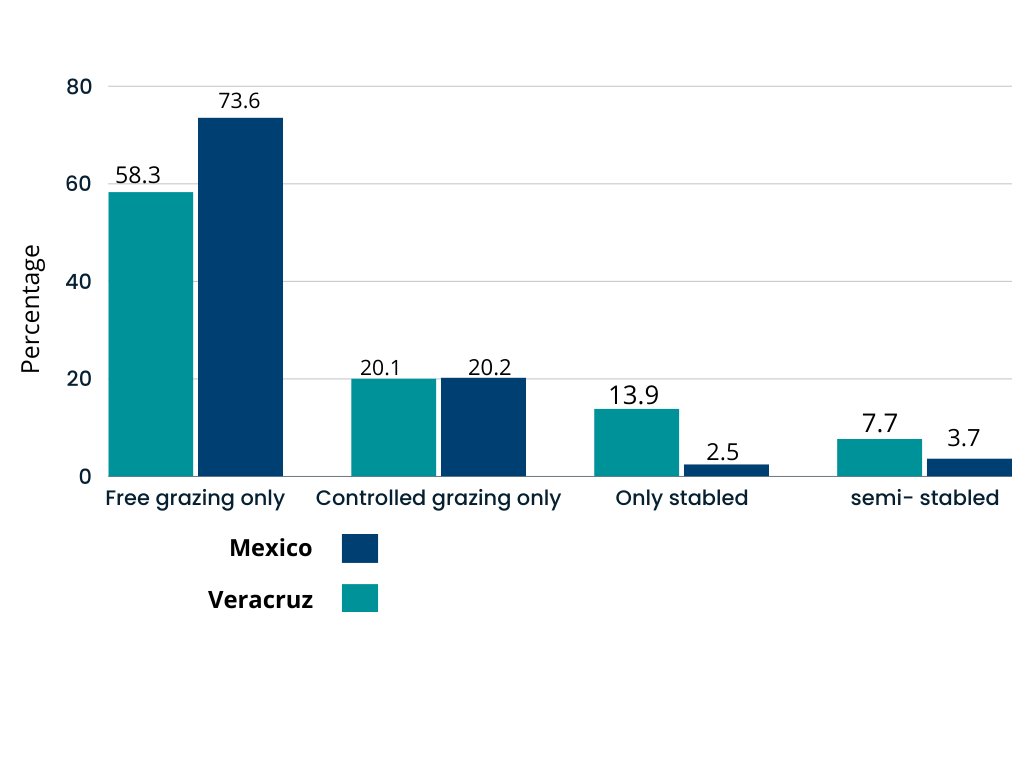
Figure 6. Types of livestock production.
Based on interviews in southern Veracruz, somewhat less than half of livestock raisers (41%) have dual-purpose livestock, producing both meat and milk; 39% principally produced milk; and 20% principally produced meat. The majority of milk producers sell it for cheese production. Veracruz produces 3.4 million pounds of milk daily.
Conventional livestock raisers invest little in infrastructure and produce breeding stock for sale to middlemen who transport livestock to large ranches or industrial feedlots. A majority (72%) of conventional livestock raisers sell livestock at age 10 months to 2 years, at an approximate weight of 160 to 230 kg; only 12% sell livestock at age 3, or 300-400 kg. (Table 1).
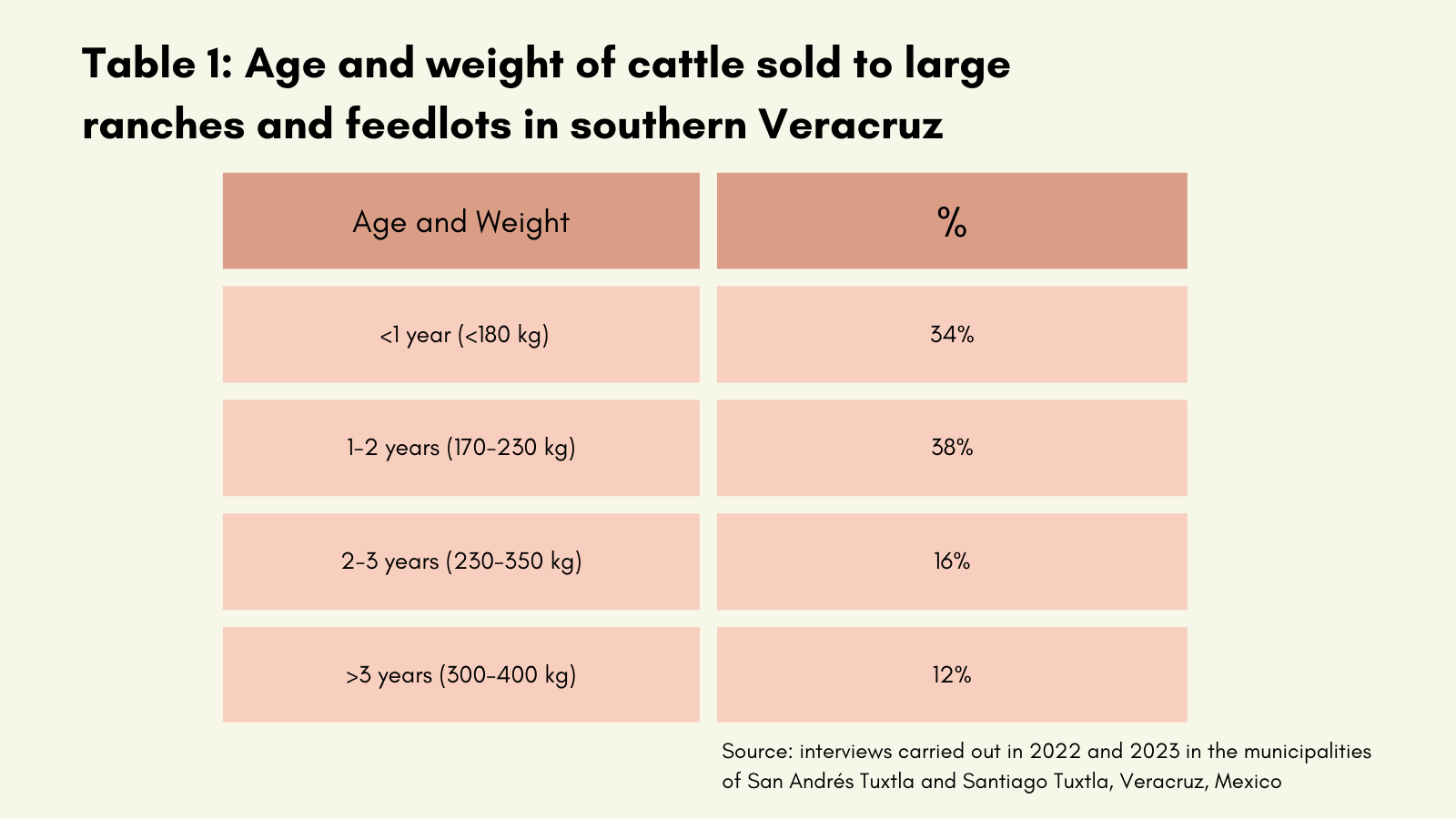
Table 1. Age and weight of cattle sold to large ranches and feedlots in southern Veracruz. Source: interviews carried out in 2022 and 2023 in the municipalities of San Andrés Tuxtla and Santiago Tuxtla, Veracruz, Mexico.
Economic and political challenges to transitioning to sustainable livestock raising
In Veracruz, several types of livestock raisers exist, according to overall area used for livestock raising (5-1000 hectares) and the product produced (meat, milk, or dual purpose). Currently, the most significant difference among cattle ranches is whether livestock are raised during both the first and second weight stages (<180 - 230 kg) on the cattle raiser’s land or whether they are raised during the second stage by regional “fattening ranches”, which typically house 500 to 800 cattle. Small- and medium-scale livestock raisers with limited pasture sell their cattle at age 10 months to approximately 2 years (150-230 kg), while large-scale livestock raisers with sufficient pasture to maintain their livestock tend to sell them at age 2 to 3 years (300 kg). Following this, the cattle are purchased by middlemen who take them to regional fattening ranches where they remain until reaching 350 kg upon which they are sold to large feedlots, or large feedlots with over 50,000 cattle where they remain until reaching 500-600 kg. Many fattening ranches specialize in receiving 150 kg calves to raise them until they reach 280-350 kg by feeding them a diet of fibre and feed concentrate (approximately 70% and 30%, respectively). Following this, a 3-6 month termination period before slaughter consists of raising the cattle in large feedlots with over 50,000 cattle on a diet of 70% feed concentrate and 30% fibre.
Although the greatest profits are made during the later fattening stages, one of the greatest economic challenges for small- and medium- scale livestock raisers is to maintain their livestock until at least 2 years of age. Due to economic pressures and lack of grass, small-and medium scale livestock raisers face a greater risk of death of livestock than do larger-scale livestock raisers and are obliged to sell them at a younger age and lower weight (approximately 180-220 kg at 1-2 years of age, depending on the breed and management practices used).
One of the greatest economic challenges to sustainable livestock raising is achieving profitability while fattening livestock outdoors on ranches based on a combination of highly nutritious plants and grasses, which could reduce negative ecological impact and improve animal welfare. Intensifying livestock management by rotating the animals every day or two in enclosures with electric fences may improve ecological sustainability. Fattening for a longer time on grasses and other plants (e.g. Leguminosae and Tithonia spp) increases the nutritional quality of the diet as well as carrying capacity, which allows the liberation of areas for recovery of forests. Furthermore, taking advantage of dung beetles (Coleoptera/Scarabaeidae) to incorporate excrement into the soil promotes soil nutrition and conservation and potentially contributes to soil carbon capture (Santos & Boege, 2022).
In other regions of Mexico and of Latin America, particularly Colombia, agrosilvopastoral and silvopastoral systems have been shown to provide many socioecological benefits as a result of including trees in pastures; establishing diverse plant associations and corridors connecting islands of vegetation in pastures to natural protected areas; protecting water sources; and diversifying farmers’ economies (Ferguson et al., 2013; Douterlungne & Ferguson 2016). Furthermore, they provide economic benefits to farm families by increasing meat production 5-fold and milk production by 80% per unit of land as compared to extensive livestock raising (Chará et al., 2019; Murgueitio et al., 2015; Santos & Boege 2022).
Despite these benefits, fattening livestock in open agrosilvopastoral systems takes more time and is less profitable than in feedlots with over 50,000 animals in a smaller space in which they are fattened from 250 to 550 kg in 7 to 10 months, despite the high cost of feed and vaccines. Essentially, these livestock are treated as fattening machines, ignoring their wellbeing, and leading to high levels of CO2 and methane production. Furthermore, the feedlots’ enormous profits are a result of reducing the cattle fattening period, as well as the fact that feedlot workers are provided with very low wages. Meanwhile, cattle fed on grass and other plants may take over 3 years to reach slaughter, depending on the environmental and economic conditions.
Given that the longer time needed for raising free-range livestock may partially counterbalance reduction in CO2 emissions resulting from its many sustainable aspects, there is a need to modify the predominant meat production-consumption model. Reducing meat consumption would allow for doing away with massive livestock production. For decades, many nutritionists and health policies have promoted meat consumption almost as the sole protein source, and there is a need for policies promoting a wide variety of legumes and other protein-rich crops.
Furthermore, changing from feedlot production to agrosilvopastoral systems would increase animal, human, and ecological wellbeing. Transforming the predominant model requires a change in public policy regarding meat production, rather promoting sustainable livestock raising in intensive systems based on the following:
-
respect for ecological dynamics through forest restoration, caring for water sources, enriching soil by promoting the presence of coleoptera, combining grasses with highly nutritious plants as feed, and pest and disease management by rotating pastures and crops;
-
animal wellbeing through care and attention to each animal; and
-
wellbeing of livestock raisers and all workers involved in livestock raising.
Nevertheless, given political alliances among governors, municipal presidents, and heads of livestock associations, maximum profit is prioritized based on the feedlot model, disregarding environmental, animal, and human costs. As a result, feedlots have increased in Mexico, which is currently the world’s 7th largest meat producer, and which exports meat products to 15 nations.
Environmental and cultural challenges to sustainable livestock raising
Given current environmental problems, there is a need for fundamental transformation of livestock management practices that have been carried out for decades. Perhaps the most important is to shift from an extensive to an intensive system of prairies in which protein-rich plants are cultivated. With the help of electric fences, cattle raisers may divide their land into small plots (approximately 30) and rotate their cattle every day or two. This allows pastures to regenerate in 25-35 days, upon which the first plot will again be ready for grazing. In several Latin American nations, livestock raisers have experimented with a diversity of plants as feed, including Leguminosae, improving cattle nutrition as well as soil quality (Chará et al., 2019; Murgueitio et al., 2015; Santos & Boege 2022).
In southern Veracruz, academics and NGOs have proposed to connect ecological corridors to core zones of the Los Tuxtlas Biosphere Reserve. Planting trees on the edges of plots as living fences and reforesting river edges and surrounding springs would facilitate establishment of additional ecological corridors, which would furthermore protect water sources. However, there is a need for further studies in order to better understand relationships between water sources and biodiversity, as well as involvement of local residents to establish and maintain these forest patches and corridors.
Other challenges include modifying decades-old technical aspects of livestock raising and overcoming resistance by farmers. However, the image persists of the successful livestock raiser as having very large herds and controlling genetics to obtain “more productive” breeds and investing in acquisition of larger, fatter, more costly breeds. Meanwhile, investing in infrastructure for herd rotation, intensive prairie management with grasses and other highly nutritious plants, as well as training for sustainable or so-called holistic management are not priorities.
Other cultural challenges are related to consumption. Questions such as how to reduce meat consumption - and even whether it is necessary to consume meat - must be considered. While vegetarian diets are more common in other regions of the world, in Mexico vegetarianism as a political movement is quite recent. In Latin America, the widespread custom of excessive consumption of animal protein is to a large extent due to the assumption that it is more nutritious than plant protein, as well as to pressure by corporations which have largely disregarded ecological consequences of largescale livestock production as well as animal and human wellbeing.
Nevertheless, despite these economic, cultural, and political barriers, some farmers have analysed the role of livestock raising in the current environmental crisis and are convinced of the need for a transition to sustainable livestock raising. For the past 20 years, technical advisors in Mexico - as in other nations - have provided courses on strategies for sustainable livestock management, including regenerative livestock raising and agrosilvopastoral systems, as well as comprehensive management of crops, forests, water, soil, and pest cycles, and are beginning to influence farmers’ practices in southern Veracruz.
Conclusions
Veracruz has had a long history of extensive livestock raising, provoking some of the highest rates of deforestation and biodiversity loss in Mexico. At the same time, rural indigenous and peasant populations depend on cattle raising for their livelihoods. While small- and medium-scale peasants would like to continue cultivating their milpas, climatic variability in recent years has been so high that they consider harvests of crops which depend on rainfall - particularly those cultivated in the milpa - to be unpredictable and therefore risky, threatening their subsistence. Meanwhile, although cattle raising is still highly risky, it is less so than raising crops, thereby providing them with a greater chance of meeting their families’ economic needs.
Given global as well as local environmental crises, there is a need to implement sustainable intensive livestock raising involving such practices as cultivation of grasses and other plants with a high nutritional content; daily rotation of livestock among small plots established in pastures; living fences; tree corridors along rivers and around springs; and forested patches in pastures which form biological corridors among plots and core areas of existing reserves.
Despite economic, ecological, and even cultural challenges to sustainable livestock raising, environmental deterioration - particularly with respect to reduction in volume of rivers as well as decreased rainfall and soil humidity - is convincing many small and medium-scale livestock raisers of southern Veracruz to invest in labour and infrastructure necessary for sustainable livestock raising. While many livestock raisers are beginning to resolve economic challenges to implementing these changes, all cattle raisers participating in sustainable livestock projects in southern Veracruz initiated by academics, activists, NGOs, Mexico’s Agricultural Ministry, and the Los Tuxtlas Biosphere Reserve in the past two decades continue selling their calves to middlemen who sell them to feedlots within the region or in northern Mexico.
Therefore, there is a need for changes in livestock policies to enable livestock raisers to close economic and ecological cycles in their plots and sell their products directly to local markets. Fomenting organization of markets with “green seals” would allow farmers to market to consumers who value their efforts to maintain tropical forests and their biodiversity, promote regional water security, and respect animal wellbeing.
Finally, there is a need for society to change its habits with respect to meat consumption. Reducing meat consumption would allow for doing away with massive livestock production, and replacing feedlot production with agrosilvopastoral systems that would increase animal, human, and ecological well-being. There is also a need for policies promoting reduction in meat consumption as the sole protein source, instead promoting cultivation and consumption of a wide variety of legumes and other protein-rich crops. Rather than imposing a ‘clean-cow’ future, food models must be jointly designed by farmers, NGOs, and researchers through a democratic process in order to achieve food and territorial justice.
Footnotes
- Haciendas were large estates established by the Spanish during colonial times with the purpose of controlling land, labour, crops, and livestock for subsistence, with surplus being provided to the Spanish crown.
- Nonetheless, the percentage of land distributed to landless peasants was the higher during the Cardenas Administration than in any other administrations.
- Mestizo refers to Mexicans who do not identify themselves – or are not identified - as having indigenous roots.
- Through cattle-sharing contracts, large-scale livestock raisers from elsewhere provided ejido members with half of all new-born calves (with the landowner choosing which calves would be theirs) in exchange for the ejido members providing pastureland, labor, and inputs (grass seed, fertilizer, vaccines, and medicine) necessary for raising the cattle.
Acknowledgements
I deeply thank Table Debates organization for their invitation to Oxford University during my sabbatical year. I thank the insightful and valued comments to this essay from Tara Garnett and Ruth Mattock. Thanks to PASPA (Programa de Apoyos para la Superación del Personal Académico), DGAPA, UNAM financial aid, I could spend my sabbatical period at Oxford University.
Bibliography
Adams, W. M. (1992). Wasting the Rain. Rivers, people and planning in Africa. University of Minnesota Press, London.
Barrera, N. & H. Rodriguez (Eds) (1982). Desarrollo y medio ambiente en Veracruz. Impactos económicos, ecológicos y culturales de la ganadería en Veracruz. Ed. CIESAS-Golfo, Instituto de Ecología y Friedrich Erbert Stiftung, México.
Chauvet, M. (1999). La ganadería Bovina de carne en México: del auge a la crisis. Universidad Autónoma Metropolitana, México.
Chará, J., Reyes, E., Peri, P., Otte, J., Arce, E., & Schneider, F. (2019). Silvopastoral systems and their contribution to improved resource use and sustainable development goals: evidence from Latin America. The Food and Agriculture Organization of the United Nations, Cali.
Collis, J. (1986). Smallholder Settlement of Tropical South America: The social causes of ecological destruction, Human Organization, 45 (1), 1-10. https://doi.org/10.17730/humo.45.1.0742x12223u09x01
Dirzo, R. & García, M. (1992). Rates of deforestation in Los Tuxtlas, a Neotropical area in southeast Mexico. Conservation Biology, 6, 84–90. https://doi.org/10.1046/j.1523-1739.1992.610084.x
Douterlungne, D., & Ferguson, B. (2016). Estrategias para el establecimiento de árboles en pastizales para la restauración de la selva húmeda en Chiapas. In: E. Ceccon, E. & C. Martínez Garza (Eds.), Experiencias mexicanas en la restauración de ecosistemas (pp.275-294) Universidad Autónoma de México, México.
Feder, E. (1982). Vacas Flacas, Ganaderos gordos: las ramificaciones internacionales de la industria del ganado vacuno en México. In: J. Larraguivel (Eds.), El desarrollo agroindustrial y la ganadería en México. (pp.341-365) SARH, México.
Fernández Ortiz, L. M., Tarrio M., & Villafuerte Solis, D. (1993). La expansión Ganadera en Veracruz: sus impactos en la economía y en la producción de Alimentos. In: Barrera, N. & H. Rodriguez (Eds), Desarrollo y medio ambiente en Veracruz. Impactos económicos, ecológicos y culturales de la ganadería en Veracruz. (pp.15-33).CIESAS-Golfo, Instituto de Ecología y Friedrich Erbert Stiftung, México.
Ferguson, B., Stewart, A. W., Alfaro-Arguello, R., Martin, J., Nahed, J., D. Álvarez-Solís, D., & Pinto-Ruíz, R. (2013). Sustainability of holistic and conventional cattle ranching in the seasonally dry tropics of Chiapas, México. Agricultural Systems, 120, 38-48, doi:10.1016/j.agsy.2013.05.005
Flores López, J. (2014). Ganadería a medias en la sierra de Santa Martha,Veracruz. Revista de Estudios agrarios, 20 (57), 199-220.
Hecht, S., & Cockburn, A. (1990). The fate of Developers, Destroyers and Forest Defenders of the Amazon. Harper Collins Publishers, Nueva York.
Hurts, P. (1990). Rainforest Politics. Ecological Destruction in South-East Asia. Zed Books, New Jersey.
Lazos, E. (1996). La Ganaderización de dos Comunidades Veracruzanas: Condiciones de la Difusión de un Modelo Agrario. In: L. Paré & M.J. Sánchez (eds.), El ropaje de la tierra. Naturaleza y Cultura en cinco zonas rurales. (pp.117-242) Universidad Autónoma de México, México.
Lazos, E. (2001). Ciclos y rupturas. Dinámica ecológica de la ganadería en el sur de Veracruz.In. L. Hernández (Ed.), Historia Ambiental de la Ganadería en México, (pp.133-153). Instituto de Ecología. México.
Murgueitio, E., Flores, M., Calle, Z., Chará, J., Barahona, R., Molina, C., & Uribe, F. (2015). Productividad en sistemas silvopastoriles intensivos en América Latina. Fundación CIPAV, Colombia.
Ordoñez, M. J., & García, F. (1992). Zonificación Ecoproductiva de Veracruz. In: E. Boege and H. Rodriguez (Eds), Desarrollo y medio ambiente en Veracruz (pp.31-50). Centro de Investigaciones y Estudios Superiores en Antropología Social del Golfo, México.
Pérez, J.C., & Mackinlay H. (2015). ¿Existe aún la propiedad social agraria en México? Polis: Investigación y Análisis Sociopolítico y Psicosocial, 45(1), 45-82. Universidad Autónoma Metropolitana.
Pezo, D., & Ibrahim, M. (1996). Pastoreo intensivo en zonas tropicales. - In 1er Foro internacional, México.
Reig, N. (1982). El sistema ganadero Industrial: su estructura y desarrollo 1960-80. In: J. Nava (ed.), El Desarrollo Agroindustrial y la Ganadería en México (pp.19-240). SARH, México.
Reina, L. (1998). Las rebeliones campesinas en México, 1819-1906. Ed. Siglo Veintiuno, México.
Revel- Mouroz J. (1980). Aprovechamiento y colonización del trópico húmedo Mexicano. La vertiente del Golfo y el Caribe. Ed. Fondo de Cultura Económica, México.
Santos, R. & Boege K. (2022). Biodiversity islands: Biodiversity islands: the role of native tree islands within silvopastoral systems in a neotropical region. In: F. Montagnini (Ed.) Biodiversity Islands. Strategies for Conservation in Human Dominated Environments (pp.118-138). Springer.
Toledo, V, M. (1990). El proceso de ganaderización y la desestructuración biológica y ecológica de México. Porrúa, México.
Tudela, F. (1989). La modernización forzada del trópico: El caso de Tabasco. Proyecto integrado del Golfo. Ed. El Colegio de México, México.
Velazquez, E. (2000). Ganadería y poder político en la sierra de Santa Marta. In: E. Léonard & E. Velázquez. (Eds.) El Sotavento veracruzano: procesos sociales y dinámicas territoriales (pp-111-128). CIESAS, México.
Velasco, J. (1993). Pobreza y Ganaderización en las Regiones Interétnicas de Veracruz. en N. Barrera & H. Rodríguez (Eds.), Desarrollo y Medio Ambiente en Veracruz. Impactos Económicos, Ecológicos y Culturales de la Ganadería en Veracruz (pp.83-107). Ed. CIESAS-Golfo, Instituto de Ecología y Friedrich Erbert Stiftung, México.
Von Wobeser, G. (2019). La formación de la hacienda en la época colonial. El uso de la tierra y el agua. Ed. Universidad Nacional Autónoma de México, Instituto de Investigaciones Históricas, México.







Post a new comment »